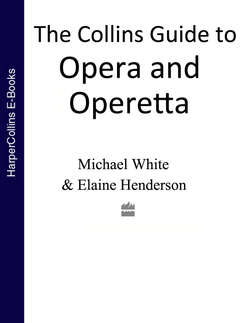Читать книгу The Collins Guide To Opera And Operetta - Michael White - Страница 41
ОглавлениеDeath in Venice
FORM: Opera in two acts; in English
COMPOSER: Benjamin Britten (1913–76)
LIBRETTO: Myfanwy Piper; after Thomas Mann’s story
FIRST PERFORMANCE: Snape, 16 June 1973
Principal Characters
Gustav von Aschenbach, a writer Tenor
The Traveller (multiple role) Bass-baritone
Voice of Apollo Countertenor
Tadzio, a Polish youth Choreographed role
His mother Silent role
Synopsis of the plot
Setting: Munich and Venice; 1911
ACT I At home in Munich Aschenbach is weary and disillusioned with his work and unable to write. He decides to travel south to Venice, to try and regain his creative powers. On the boat Aschenbach is surrounded by several young, lighthearted passengers, among whom, incongruously, is an elderly man with rouged cheeks and dyed hair. At his hotel on the Lido, Aschenbach notices a Polish family, including Tadzio, a boy of immense physical beauty to whom he is immediately attracted. On a trip into Venice, Aschenbach finds the city suffocating and claustrophobic, and he decides to cut short his stay. But when his luggage is mistakenly sent to Como instead of back to Germany, he changes his mind and agrees, not unhappily, to stay on. Aschenbach slowly becomes obsessed with Tadzio, barely able to take his eyes off him as he plays games on the beach, and finally admitting to himself that he loves the boy.
ACT II Aschenbach hears rumours of a fever in Venice, but the hotel barber is evasive, and Aschenbach is anxious to conceal the truth from Tadzio’s family in case they leave. As the rumours grow more insistent, Aschenbach’s behaviour becomes more bizarre as he starts to follow Tadzio’s family wherever they go. At last the cholera epidemic is generally acknowledged and the visitors are advised to leave before the city is sealed off. Still Aschenbach does not tell Tadzio’s family; all he cares about is that they will not leave. His thoughts become more heated and intense; he convinces himself that Tadzio understands and even returns his love. To make himself more attractive he has his hair dyed and his face rouged in a ghastly travesty of youth. By now the hotel is almost empty and Aschenbach learns that the Polish family are about to leave. He goes to the beach one last time to watch Tadzio. When the boy falls during a game, Aschenbach calls out his name in anguish before he collapses, dying, in his chair.
Music and Background
This is Britten’s last opera, written with extraordinary refinement for the specific vocal qualities of Peter Pears in the final stage of his singing career. The central role is all-important, rivalled only by that of the baritone who, in a virtuoso performance, takes on seven different characters – all of them agents in the process of advancing Aschenbach towards his death. The orchestration is especially striking: economical, precise but deep-dyed with exotic oriental colouring inspired by the sound of Javanese gamelan music and used to suggest the fatal allure of the boy Tadzio.
Highlights
The power of Death in Venice is cumulative rather than dependent on ‘big’ moments; but the Beach-games Scene at the end of Act I is peculiarly evocative, and the Dream Scene in Act II a disturbing example of stage-trauma. Listen for the rocking, barcarolle motif that literally ferries Aschenbach to his grave.
Did You Know?
Visconti’s film of Death in Venice came out while Britten was planning his opera, and the composer determined not to see it lest he be accused of plagiarism. In any event, Britten stayed closer to the book than Visconti did, including the academic debate on the nature of attraction that makes Death in Venice more than just a love story.
Recommended Recording
Peter Pears, John Shirley-Quirk, James Bowman, English Chamber Orchestra/Steuart Bedford. The original cast recording made in 1974 after the premiere at Snape Maltings, Suffolk.
